Nursery Management: International - A world of difference
Gabriella Jozwiak
Monday, March 19, 2018
We often talk about deprivation from a UK perspective, yet we are one of the richest countries in the world. How is it tackled in developing countries? Gabriella Jozwiak reports

Download the pdf of this article
Globally almost half of all three- to six-year-old children (159 million) are deprived of access to pre-primary education, according to the World Bank. This is despite worldwide recognition that a child’s first years provide a window of opportunity to prevent future inequality.
Investing in this area improves children’s cognitive, linguistic, social and emotional skills, and makes them more likely to learn better at primary school and to earn higher wages later as adults.
PERU: ADDRESSING INEQUALITY IN LIMA
Just over half of all three-year-olds in Peru were enrolled in some form of early education in 2015, according to the country’s National Institute of Statistics and Information. Among four-year-olds, the proportion was 90.7 per cent, while among five-year-olds it was 95.3 per cent. However, inequality of access is a problem. An Oxford University study from 2012 suggested children from poorer households were more than seven times less likely to attend an early learning centre than those from households classified as ‘less poor’. The World Bank in 2015 said 9 per cent of the country lived in extreme poverty – living on less than $2.5 (£1.87) a day – while just over 19 per cent were considered to be in moderate poverty on $4 (£2.99) a day.
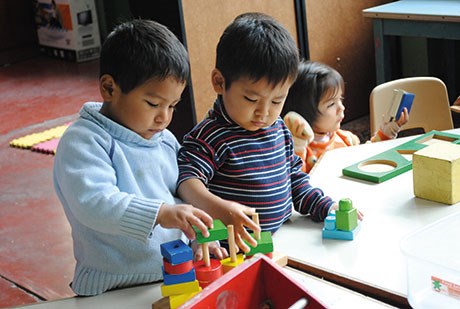 Non-profit organisation Cuna Nazareth runs a nursery specifically targeting low-income families in the Chorrillos district of Peru’s capital, Lima. A group of Swedish and Finnish volunteers founded the setting in 1962 after noticing parents were leaving children alone at home to go out to work. Today it offers 130 daycare places for nine hours a day to children aged from one to five. The only charge is about £1.50 a day towards the cost of three meals a day and snacks, while the rest is funded through charitable grants and donations – estimated to be about 16 per cent of an average low-income salary. The poorest families can access childcare for children under 36 months for as little as three soles per day under a government scheme called Cuna Mas (‘cuna’ meaning cradle).
Non-profit organisation Cuna Nazareth runs a nursery specifically targeting low-income families in the Chorrillos district of Peru’s capital, Lima. A group of Swedish and Finnish volunteers founded the setting in 1962 after noticing parents were leaving children alone at home to go out to work. Today it offers 130 daycare places for nine hours a day to children aged from one to five. The only charge is about £1.50 a day towards the cost of three meals a day and snacks, while the rest is funded through charitable grants and donations – estimated to be about 16 per cent of an average low-income salary. The poorest families can access childcare for children under 36 months for as little as three soles per day under a government scheme called Cuna Mas (‘cuna’ meaning cradle).
Cuna Nazareth’s head, Carmen Rosa Santa Cruz Espinoza, says a high proportion of children attending the setting have learning difficulties, health and emotional problems. ‘Many of the families are migrants who have come to the capital looking for economic opportunities,’ she says. ‘They lack housing and live in areas without basic services.’
Eight qualified teachers lead care at the nursery, alongside care assistants and specialists such as an educational psychologist. They follow the methodology of Desarrollo Infantil Temprano, meaning ‘Early Childhood Development’, which states that a child’s physical, mental and emotional development are aided when carers support them to achieve the next developmental level. ‘We prepare experiential and playful activities for children aged three to five, and consider play to be a fundamental part of their development,’ explains Ms Espinoza. Activities include playing with wooden blocks and puzzles, outdoor games such as football, and visits from Father Christmas and his elves.
The setting also runs workshops for parents to enable them to better support their children’s emotional needs and nutritional requirements. ‘One of the nursery’s challenges is to help reduce malnutrition among the children, and other illness, by providing balanced meals and health checks,’ says Ms Espinoza.
After attending the nursery, children go on to primary education in local state-funded schools. ‘If the children did not come to Cuna Nazareth they would have been cared for by neighbours, relatives or older siblings at home, who would not have educated them,’ says Ms Espinoza.
Nursery World’s Study Tour to Peru (27 May-7 June) will visit Cuna Nazareth, see www.nurseryworld.co.uk/study-tour.
UGANDA: IMPROVING TEACHING QUALITY
Uganda has a reputation for rapid poverty reduction. According to the World Bank, the proportion of the Ugandan population living below the national poverty line declined by more than a third from 31.1 per cent in 2006 to 19.7 per cent in 2013. However, despite these improvements, figures from Unicef suggest 55 per cent of Uganda’s children under five still live in poverty. One threat to continued improvements, the World Bank warns, is that while education is available, its quality is poor.
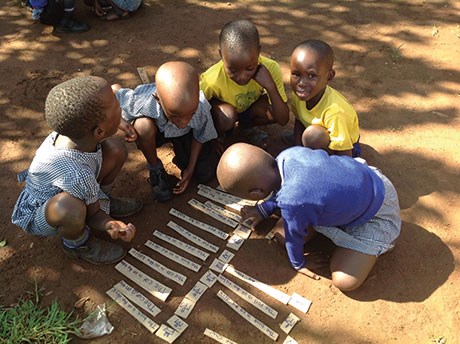 British charity Redearth Education is challenging this eventuality by training nursery school teachers from typically poorer rural areas in a purpose-built early education setting. Its nursery in Masindi Town follows government pre-primary curriculum guidelines exactly – the Learning Framework for Early Childhood Development (ECD). Like the EYFS, this is split into areas of learning and development. The five include language, mathematics and ‘relating with others in an acceptable way’. It also stipulates pre-schools must have classes for three separate age groups: three to four, four to five and five to six, each of 25 children.
British charity Redearth Education is challenging this eventuality by training nursery school teachers from typically poorer rural areas in a purpose-built early education setting. Its nursery in Masindi Town follows government pre-primary curriculum guidelines exactly – the Learning Framework for Early Childhood Development (ECD). Like the EYFS, this is split into areas of learning and development. The five include language, mathematics and ‘relating with others in an acceptable way’. It also stipulates pre-schools must have classes for three separate age groups: three to four, four to five and five to six, each of 25 children.
Despite this national standard for early education, charity co-founder Di Cosgrove, a former primary school head teacher, says education quality is variable. ‘In rural areas the teachers have had little training and the buildings are poor,’ she says. She adds that the ECD is hard for local teachers to follow because of the way it is written and their lack of understanding of activity-based learning. The ECD states that rote learning is unhelpful for pre-school-aged children. Yet the teachers’ own experience of school was such. ‘They don’t quite understand at first the purpose of play,’ says Ms Cosgrove. ‘We spent a lot of time helping them understand what the expectations are.’
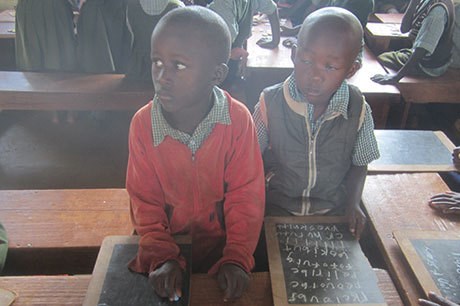 The setting opened in 2015, following a decade of training teachers in the country. So far, six teachers have completed this latest programme. They will take their knowledge back to nurseries in six separate villages.
The setting opened in 2015, following a decade of training teachers in the country. So far, six teachers have completed this latest programme. They will take their knowledge back to nurseries in six separate villages.
Much of their training involves observing the nursery’s children, who come from slightly better-off families. In the town, parents work as shopkeepers or teachers rather than subsistence farmers, as is typical in the ‘bush’ or rural areas. Here, parents may keep younger children home to help with farming or market-day selling.
As few educational resources are available in the bush, Redearth trains teachers to make games and teaching aids out of found materials, such as cardboard, plastic bottles and clay.
Nursery fees are around 230,000 Ugandan shillings per term – about £40, or 72p per day. This covers the cost of staff salaries, but the nursery does not make a profit. The setting also takes five pupils – usually orphans or vulnerable children – paid for by UK sponsors.
According to the setting’s founders, fees for a nursery offering education of this quality in Kampala would be up to two million Ugandan shillings per term – around £425.
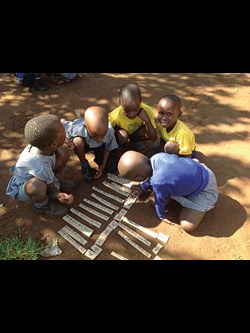 In the Masindi setting, the high standards are proving successful. The charity claims that its pupils are able to read all letter sounds and at least 70 words after 18 months’ attendance, compared with pupils at neighbouring nurseries only recognising sounds at this stage and reading only two words.
In the Masindi setting, the high standards are proving successful. The charity claims that its pupils are able to read all letter sounds and at least 70 words after 18 months’ attendance, compared with pupils at neighbouring nurseries only recognising sounds at this stage and reading only two words.
Ms Cosgrove says the approach has created a ‘huge change’ in the way teachers are teaching.
‘Once they’ve realised how much these children learn not just by sitting in rows and being talked at, they become very inventive and find different ways of teaching,’ she explains.
She adds that the teachers have even written their own books for children to read.
INDIA: HELPING CHILDREN TO STAY IN SCHOOL
In India, 22 per cent of the population – about 270 million people – survive on less than $1.90 (£1.42) a day, according to the World Bank. Of these, 80 per cent live in rural areas, where despite good education provision, including pre-schools, 45 per cent of the poor population is illiterate. Only 25 per cent complete primary education. In 2016, India’s Annual Status of Education Report found that in rural areas, enrolment levels for primary school (ages six to 14) were high, at 96.9 per cent. However, researchers also reported daily absence levels of almost 20 per cent.
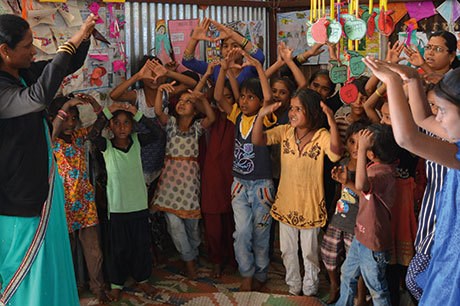 Door Step School is one Indian charity trying to get children to start and stay in school. It operates in two cities, Mumbai and Pune, where it largely targets immigrant families from rural areas. Founder Rajani Paranjpe first noticed the problem while working for a school social services team. ‘A major activity of the centre was visiting the homes of drop-out children, trying to determine the cause and bring them back to school,’ she says.
Door Step School is one Indian charity trying to get children to start and stay in school. It operates in two cities, Mumbai and Pune, where it largely targets immigrant families from rural areas. Founder Rajani Paranjpe first noticed the problem while working for a school social services team. ‘A major activity of the centre was visiting the homes of drop-out children, trying to determine the cause and bring them back to school,’ she says.
Door Step, founded in 1988, aims to bring education to where children are, be that a corrugated iron shack on a construction site, or a hut in a slum. In 2015/16, Door Step ran 170 centres for around 4,600 children aged from three to six, known as Balwadis, or pre-primary schools. It also provided 116 crèches for birth to three-year-olds.
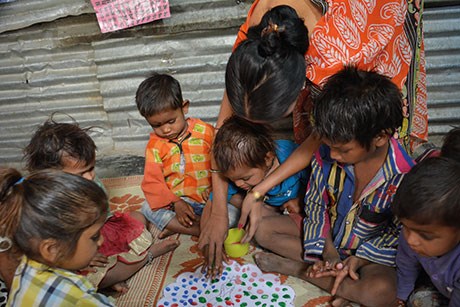 The Balwadis are open from 9.30am to 5.30pm while the children’s parents work. Staff, who are mainly educated to secondary school level, are trained to teach by the charity. It has developed its own methodology of using tools and games for the children to do individually and in groups. They include stacking toys, puzzles, sewing boards and a ‘sense jars’ filled with items with unique scents and textures. They aim to make learning fun, and teach language, numeracy, shapes and colours. This is contrary to many pre-schools on India, which focus on rote learning of reading, writing and arithmetic, despite this being against the country’s National Policy on Education.
The Balwadis are open from 9.30am to 5.30pm while the children’s parents work. Staff, who are mainly educated to secondary school level, are trained to teach by the charity. It has developed its own methodology of using tools and games for the children to do individually and in groups. They include stacking toys, puzzles, sewing boards and a ‘sense jars’ filled with items with unique scents and textures. They aim to make learning fun, and teach language, numeracy, shapes and colours. This is contrary to many pre-schools on India, which focus on rote learning of reading, writing and arithmetic, despite this being against the country’s National Policy on Education.
Without Door Step’s intervention, Ms Paranjpe says it is likely such immigrant children would be at home, despite pre-primary education being free in government schools. She explains that uneducated parents from deprived backgrounds have no idea where to begin to enrol a child. Many are unaware of a law passed in 2009 that removes the need for children to hold official documents, such as a birth certificate, to start school.
 For this reason, the charity also trains parents on how to support a child’s education. This includes waking children up on time and providing them with food rather than lunch money, which Ms Paranjpe says encourages children to leave school premises. They also explain how to obtain school-leaver’s certificates to transition to another school. Ms Paranjpe says the training results in children having ‘higher attendance of school, even when they have moved to a different location’.
For this reason, the charity also trains parents on how to support a child’s education. This includes waking children up on time and providing them with food rather than lunch money, which Ms Paranjpe says encourages children to leave school premises. They also explain how to obtain school-leaver’s certificates to transition to another school. Ms Paranjpe says the training results in children having ‘higher attendance of school, even when they have moved to a different location’.
Ms Paranjpe is realistic about how much her organisation can achieve, but says while some children will still drop out, having a taste of pre-primary learning can make a difference. ‘That experience will give them aspirations for their own children,’ she says.
COSTA RICA: REFUGEE CHILDREN IN A DANGEROUS NEIGHBOURHOOD
La Carpio is a uniquely deprived district of Costa Rica’s capital San Jose. While the rest of the country has one of the lowest poverty rates in Latin America and the Caribbean, La Carpio is home to Nicaraguan refugees and their descendants who fled there during civil war in the 1980s. Today about 26,000 residents are packed into an area where one third of inhabitants aged over 15 are unemployed, and crime and drug abuse is rife.
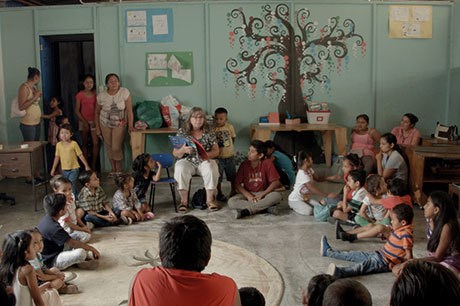 The Costa Rican Humanitarian Foundation has supported this community since 1997 through numerous projects. It estimates a quarter of residents live in poverty, particularly those residing on the banks of a polluted river.
The Costa Rican Humanitarian Foundation has supported this community since 1997 through numerous projects. It estimates a quarter of residents live in poverty, particularly those residing on the banks of a polluted river.
Charity founder Gail Nystrom says many are single mothers with multiple children. Some stay at home rather than work, but have poor parenting skills. ‘The children will be underfed and bordering on neglected,’ she says. At the other extreme are mothers who work but leave children home alone. ‘Often, older siblings will be in charge,’ says Ms Nystrom. ‘There have been two incidents of houses burning down and children dying because they were locked in while their mothers weren’t home.’
In general, nurseries do not have high attendance ‘because people are not able to pay even $20 per week for 12 hours and four meals a day’, she adds, estimating that average income is around $80 per week and is often not steady.
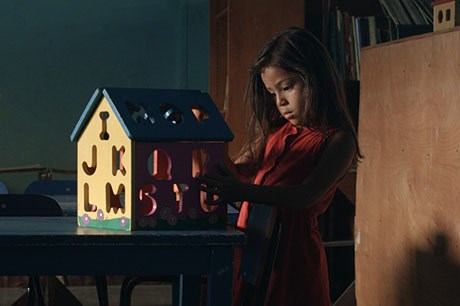
In 2009, the foundation opened a daycare centre to respond to this problem. This is free, in contrast to two fee-paying nurseries in La Carpio set up by churches. Although the Costa Rican government made pre-school compulsory in 1997, La Carpio is classified as an illegal settlement. Therefore the government has no responsibility to deliver early education provision.
Ms Nystrom arranges for local women to be trained in delivering childcare at nearby Montessori nurseries. The setting takes babies from three months, with attendance varying depending on when mothers are in work.
‘We try to keep the Montessori philosophy of independence and respect for children, the prepared environment and the role of the teacher as guide,’ says Ms Nystrom. The teachers lead theme-based activities, free play, arts and crafts, and provide breakfast, lunch and snacks and serve a hot lunch on Saturdays. Links with a local clinic provide health and mental health support.
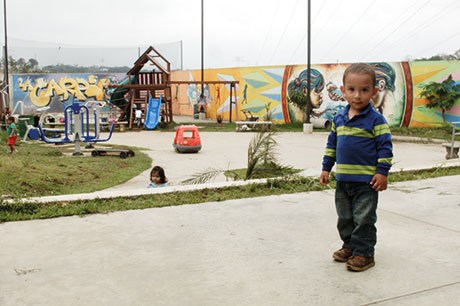 Many children need additional emotional support as they face unstable home environments. In some this has led to delayed development, for example, in speech. Death of loved ones is one issue children face prematurely as a result of local violence and drug abuse. Ms Nystrom has recruited volunteer psychologists from the US to support such cases.
Many children need additional emotional support as they face unstable home environments. In some this has led to delayed development, for example, in speech. Death of loved ones is one issue children face prematurely as a result of local violence and drug abuse. Ms Nystrom has recruited volunteer psychologists from the US to support such cases.
As the children grow older, the foundation continues to prepare them for school at age six at the charity’s Model Education Centre. ‘The difference between children who go to our programmes regularly and those who don’t is marked,’ says Ms Nystrom. The latter ‘don’t follow directions, they cry more easily, they are more anxious and ask for more attention. They can’t give answers to questions like, “Why do we brush our teeth?” They are definitely less clean and not well dressed.’
Ms Nystrom adds that feedback from state school teachers about children who have attended her settings is positive. ‘They tell us these children arrive very prepared and advanced for their age.’





